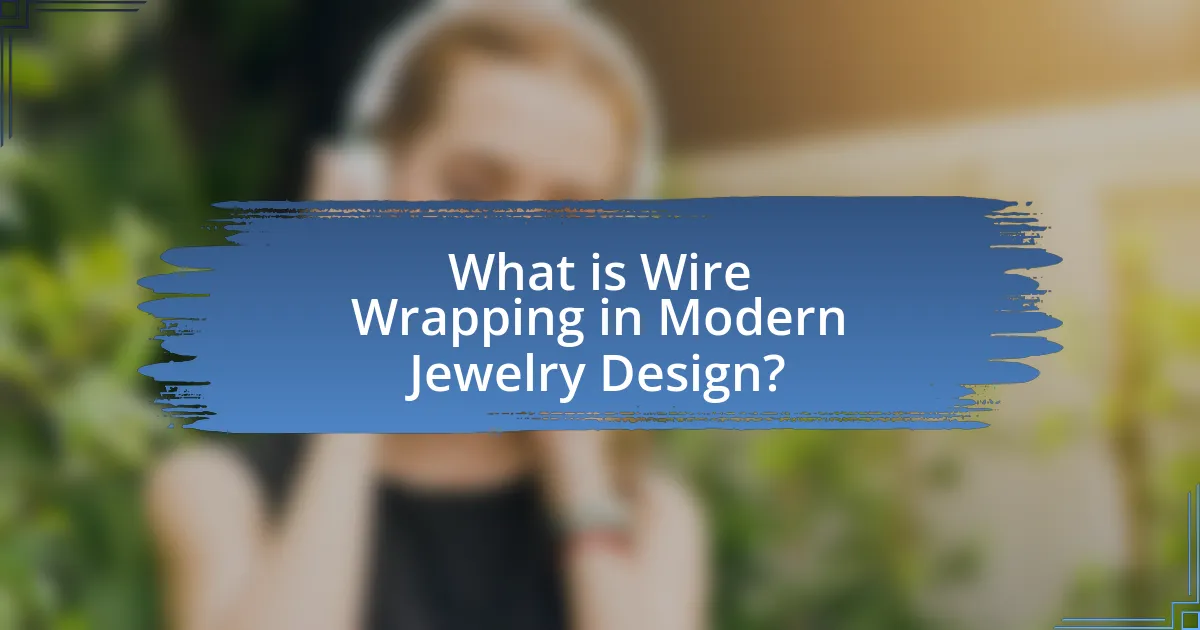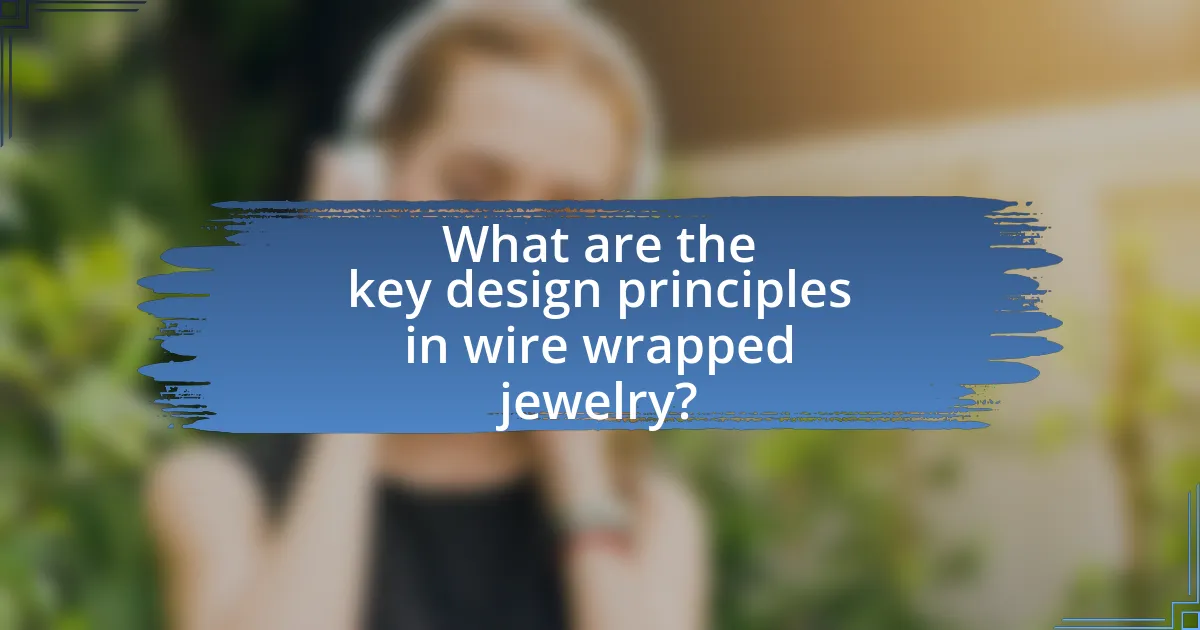Wire wrapping is a contemporary jewelry design technique that utilizes wire to create intricate patterns and secure gemstones or beads without soldering. This article explores the evolution of wire wrapping as an art form, tracing its historical roots from ancient civilizations to modern practices. It examines the materials commonly used, essential techniques for successful wire wrapping, and the impact of design principles such as color theory and texture on the final pieces. Additionally, the article addresses challenges faced by artisans, common mistakes made by beginners, and best practices for creating durable and unique wire-wrapped jewelry.

What is Wire Wrapping in Modern Jewelry Design?
Wire wrapping in modern jewelry design is a technique that involves using wire to create intricate designs and secure gemstones or beads without the need for soldering. This method allows artisans to craft unique pieces by manipulating wire into various shapes and patterns, often enhancing the visual appeal of the jewelry. The versatility of wire wrapping is evident in its ability to accommodate different materials, such as precious metals and semi-precious stones, making it a popular choice among contemporary jewelers.
How did wire wrapping evolve as an art form?
Wire wrapping evolved as an art form through the integration of ancient techniques and modern creativity. Initially, wire wrapping was used in ancient civilizations for functional purposes, such as securing stones in jewelry, with techniques documented in cultures like the Egyptians and Greeks. Over time, artisans began to explore wire wrapping as a means of artistic expression, incorporating intricate designs and personal styles. The rise of the craft movement in the 20th century further propelled wire wrapping into a recognized art form, as artists began to experiment with various materials and techniques, leading to the contemporary styles seen in modern jewelry design today. This evolution reflects a blend of historical craftsmanship and innovative artistic exploration.
What historical influences shaped wire wrapping techniques?
Wire wrapping techniques have been shaped by various historical influences, notably ancient jewelry-making practices, cultural exchanges, and technological advancements. Ancient civilizations, such as the Egyptians and Greeks, utilized wire wrapping to create intricate jewelry, often incorporating gemstones and precious metals, which laid the foundation for modern techniques. The Renaissance period saw a revival of interest in craftsmanship, leading to more refined wire wrapping methods. Additionally, the Arts and Crafts movement in the late 19th century emphasized handmade artistry, further influencing contemporary wire wrapping styles. These historical contexts demonstrate the evolution of wire wrapping as a blend of tradition and innovation in jewelry design.
How has wire wrapping been integrated into contemporary jewelry?
Wire wrapping has been integrated into contemporary jewelry by serving as a versatile technique that enhances the aesthetic and structural qualities of pieces. This method allows artisans to create intricate designs by manipulating wire to secure gemstones and other materials, resulting in unique, handcrafted items that reflect personal style. The rise of DIY jewelry-making and the popularity of artisan markets have further propelled wire wrapping into mainstream fashion, with many designers incorporating it into their collections to offer distinctive, customizable options. Additionally, wire wrapping has gained recognition in educational settings, with workshops and online tutorials making the technique accessible to a broader audience, thus fostering a community of enthusiasts and professionals alike.
What materials are commonly used in wire wrapping?
Common materials used in wire wrapping include various types of wire, gemstones, and beads. The wire is typically made from metals such as copper, silver, or gold-filled materials, which provide durability and aesthetic appeal. Gemstones and beads serve as focal points in wire-wrapped jewelry, with options ranging from natural stones like quartz and amethyst to glass and crystal beads. The choice of these materials is essential for creating intricate designs and ensuring the structural integrity of the finished piece.
What types of wire are preferred for jewelry making?
The preferred types of wire for jewelry making include sterling silver, gold-filled, copper, and aluminum wire. Sterling silver is favored for its durability and aesthetic appeal, while gold-filled wire offers a luxurious finish at a lower cost than solid gold. Copper wire is popular for its malleability and affordability, making it ideal for beginners. Aluminum wire is lightweight and comes in various colors, appealing to those looking for versatility in design. These materials are commonly used due to their workability and the quality of finished pieces they produce.
How do different materials affect the final design?
Different materials significantly influence the final design in wire wrapping jewelry by affecting aesthetics, durability, and functionality. For instance, using metals like sterling silver or gold enhances the visual appeal and longevity of the piece, while materials such as copper can provide a rustic look but may tarnish over time. Additionally, the choice of gemstones or beads impacts the overall design, as their colors, shapes, and sizes dictate the wire wrapping techniques employed. Research indicates that the material selection directly correlates with consumer preferences, as high-quality materials often lead to higher perceived value and desirability in jewelry design.
What techniques are essential for successful wire wrapping?
Successful wire wrapping requires techniques such as proper gauge selection, consistent tension, and effective wrapping patterns. Proper gauge selection ensures that the wire is neither too thick nor too thin for the intended design, allowing for durability and aesthetic appeal. Consistent tension during wrapping maintains the integrity of the design, preventing loose or uneven sections that can compromise the overall look. Effective wrapping patterns, such as the spiral, figure-eight, or coiling techniques, enhance the visual interest and structural stability of the piece. These techniques are foundational in wire wrapping, as they contribute to both the functionality and artistry of the jewelry created.
What basic skills should a beginner learn first?
Beginners in wire wrapping jewelry design should first learn basic skills such as wire manipulation, tool handling, and understanding wire types. Mastering wire manipulation involves learning how to bend, twist, and shape wire effectively, which is essential for creating intricate designs. Proficient tool handling includes familiarization with pliers, cutters, and other essential tools, ensuring safety and precision during the crafting process. Additionally, understanding different wire types, such as copper, aluminum, and sterling silver, is crucial as each type has unique properties that affect the design and durability of the jewelry. These foundational skills are critical for successful wire wrapping and are supported by numerous tutorials and instructional resources available in jewelry-making communities.
How can advanced techniques enhance wire wrapping designs?
Advanced techniques can enhance wire wrapping designs by allowing for greater precision and creativity in the crafting process. Techniques such as CAD (Computer-Aided Design) software enable designers to visualize and plan intricate patterns before execution, ensuring accuracy in measurements and aesthetics. Additionally, the use of specialized tools like micro soldering equipment allows for more delicate and detailed work, resulting in more complex designs that were previously difficult to achieve. These advancements not only improve the structural integrity of the pieces but also expand the range of artistic expression, as designers can incorporate more elaborate shapes and forms into their wire wrapping.

What are the key design principles in wire wrapped jewelry?
The key design principles in wire wrapped jewelry include balance, symmetry, and focal points. Balance ensures that the visual weight of the piece is evenly distributed, creating harmony in the design. Symmetry, often achieved through mirrored elements, enhances aesthetic appeal and draws the viewer’s eye. Focal points are created by strategically placing prominent stones or intricate wire designs, guiding attention and adding interest. These principles are essential for creating visually compelling and structurally sound jewelry pieces.
How does color theory apply to wire wrapping?
Color theory applies to wire wrapping by guiding the selection and combination of colors to create visually appealing jewelry designs. Understanding color relationships, such as complementary, analogous, and triadic schemes, allows artisans to enhance the aesthetic quality of their wire-wrapped pieces. For instance, using complementary colors can create striking contrasts that draw attention, while analogous colors can produce a harmonious and cohesive look. This application of color theory is supported by the principles established in art and design, which emphasize the psychological effects of color on perception and emotion, thereby influencing consumer preferences in jewelry.
What color combinations work best in wire wrapped pieces?
The best color combinations for wire wrapped pieces include turquoise with copper, amethyst with silver, and rose quartz with gold. These combinations are popular due to their aesthetic appeal and the way they enhance the natural beauty of the stones. For instance, turquoise and copper create a striking contrast that highlights the vibrant blue of the turquoise, while amethyst and silver provide a sophisticated look that complements the purple hues of the amethyst. Similarly, rose quartz paired with gold adds a warm, elegant touch, making the piece visually appealing. These combinations are favored in jewelry design for their ability to create harmony and balance in the overall appearance of wire wrapped pieces.
How can color influence the perception of a design?
Color significantly influences the perception of a design by evoking emotions, creating associations, and guiding viewer attention. In jewelry design, for instance, specific colors can convey luxury, warmth, or tranquility, impacting how a piece is received by potential buyers. Research indicates that colors like blue are often associated with trust and calmness, while red can evoke excitement and passion. This psychological response to color can enhance or detract from the overall appeal of a jewelry design, ultimately affecting consumer behavior and purchase decisions.
What role does texture play in wire wrapped jewelry?
Texture plays a crucial role in wire wrapped jewelry by enhancing visual interest and tactile appeal. The use of various textures, such as smooth, twisted, or hammered wire, creates contrast and depth, making the piece more dynamic. Textured surfaces can also catch and reflect light differently, adding to the overall aesthetic. Additionally, the choice of texture can influence the perceived value and craftsmanship of the jewelry, as intricate textures often signify a higher level of skill and artistry in the wire wrapping process.
How can different wire gauges create varied textures?
Different wire gauges create varied textures by influencing the thickness and flexibility of the wire used in jewelry design. Thicker gauges, such as 12 or 14, produce a sturdier, more pronounced texture, allowing for bold designs and structural integrity. In contrast, thinner gauges, like 20 or 24, offer greater flexibility, enabling intricate, delicate patterns and finer details. This variation in wire gauge directly affects the visual and tactile qualities of the finished piece, as thicker wires can create a more robust appearance while thinner wires can achieve a softer, more intricate look. The choice of gauge thus plays a crucial role in the overall aesthetic and functionality of wire-wrapped jewelry.
What techniques can be used to add texture to designs?
Techniques to add texture to designs include using various wire wrapping methods, incorporating mixed materials, and applying surface treatments. Wire wrapping techniques such as twisting, coiling, and braiding create intricate patterns and depth, enhancing the visual appeal of jewelry. Additionally, mixing materials like beads, stones, and metals introduces contrasting textures that enrich the overall design. Surface treatments, such as hammering or etching, can also add tactile qualities and visual interest, making the piece more dynamic. These methods are widely recognized in jewelry design, as they effectively transform flat surfaces into engaging, textured compositions.
What are common design styles in wire wrapped jewelry?
Common design styles in wire wrapped jewelry include organic, geometric, and minimalist styles. Organic designs often feature flowing lines and natural shapes, mimicking forms found in nature, while geometric styles emphasize symmetry and angular shapes, often incorporating sharp lines and precise angles. Minimalist designs focus on simplicity, using minimal wire and stones to create elegant pieces that highlight the beauty of the materials. Each style showcases the versatility of wire wrapping techniques, allowing artisans to express creativity while adhering to specific aesthetic principles.
What distinguishes bohemian wire wrapped designs from minimalist styles?
Bohemian wire wrapped designs are characterized by their intricate, freeform aesthetics, while minimalist styles emphasize simplicity and clean lines. The bohemian approach often incorporates a variety of materials, colors, and textures, creating a layered and eclectic look that reflects individuality and artistic expression. In contrast, minimalist designs focus on essential forms and a limited color palette, aiming for elegance through restraint. This distinction is evident in the use of complex patterns and embellishments in bohemian designs versus the straightforward, unadorned shapes typical of minimalist jewelry.
How can cultural influences shape wire wrapping aesthetics?
Cultural influences shape wire wrapping aesthetics by introducing distinct styles, techniques, and symbolism that reflect the values and traditions of different societies. For instance, Native American wire wrapping often incorporates natural materials and spiritual motifs, while Asian cultures may emphasize harmony and balance through intricate designs. These cultural elements not only dictate the choice of materials and colors but also influence the overall form and function of the jewelry, as seen in the use of specific gemstones that hold cultural significance. The integration of these diverse cultural aspects results in a rich tapestry of wire wrapping aesthetics that resonates with both artisans and consumers, showcasing the global nature of jewelry design.

What are the challenges faced in wire wrapping jewelry?
The challenges faced in wire wrapping jewelry include difficulty in achieving precision, managing wire tension, and selecting appropriate materials. Precision is crucial as even minor misalignments can affect the overall aesthetic and structural integrity of the piece. Managing wire tension is essential to avoid breakage or distortion during the wrapping process, which can lead to frustration and wasted materials. Additionally, selecting the right type of wire and gemstones is vital; for instance, softer wires may be easier to manipulate but less durable, while harder wires can be challenging to work with but provide greater longevity. These factors collectively contribute to the complexity of wire wrapping, requiring skill and experience to master.
What common mistakes do beginners make in wire wrapping?
Beginners in wire wrapping commonly make mistakes such as using the wrong gauge of wire, which can lead to weak structures, and failing to properly secure their wraps, resulting in loose components. Additionally, many beginners neglect to plan their designs, leading to inefficient use of materials and time. A study by the Jewelry Design Institute highlights that improper tool usage, like using pliers that are not suited for wire work, can also hinder the quality of the finished piece. These mistakes can significantly affect the durability and aesthetic of the jewelry created.
How can these mistakes be avoided or corrected?
To avoid or correct mistakes in wire wrapping, jewelry designers should focus on proper technique and practice. Ensuring that the wire is consistently tensioned during wrapping prevents loose or uneven coils, which can compromise the design’s integrity. Additionally, using the appropriate gauge of wire for the specific project enhances durability and ease of manipulation. Regularly reviewing instructional resources, such as tutorials or workshops, can provide valuable insights and corrections for common errors. Engaging with a community of wire wrapping enthusiasts allows for feedback and shared experiences, further aiding in the identification and rectification of mistakes.
What tools can help mitigate common issues in wire wrapping?
Tools that can help mitigate common issues in wire wrapping include wire cutters, round-nose pliers, flat-nose pliers, and a ruler or measuring tape. Wire cutters allow for precise cutting of wire to the desired length, reducing the risk of jagged edges that can snag or damage the design. Round-nose pliers are essential for creating loops and curves, which helps in maintaining the shape and integrity of the wire structure. Flat-nose pliers provide a firm grip for bending and twisting wire without marring its surface, ensuring a clean finish. A ruler or measuring tape assists in accurate measurements, preventing errors that could lead to uneven or misaligned components. These tools collectively enhance the efficiency and quality of wire wrapping projects.
How can one ensure durability in wire wrapped pieces?
To ensure durability in wire wrapped pieces, one should use high-quality wire and secure wrapping techniques. High-quality wire, such as sterling silver or gold-filled, resists tarnishing and breakage, enhancing the longevity of the piece. Additionally, employing tight and consistent wrapping techniques prevents the wire from loosening over time, which can lead to structural failure. Properly finishing the ends of the wire, such as by using crimp beads or wrapping them securely, further reinforces the durability of the design.
What techniques can reinforce the structure of wire wrapped jewelry?
Techniques that can reinforce the structure of wire wrapped jewelry include using thicker gauge wire, incorporating additional wire wraps, and employing structural supports like beads or stones. Thicker gauge wire provides greater strength and durability, while additional wire wraps create a more secure hold on components. Structural supports, such as beads or stones, can distribute weight evenly and enhance stability, preventing breakage. These methods are commonly utilized by jewelry makers to ensure longevity and resilience in their designs.
How does the choice of materials impact durability?
The choice of materials significantly impacts the durability of wire-wrapped jewelry. High-quality materials, such as sterling silver or gold-filled wire, resist tarnishing and corrosion, ensuring longevity. In contrast, lower-quality materials may degrade quickly, leading to breakage or discoloration. For instance, sterling silver has a high tensile strength, making it less likely to bend or break under stress, while plastic-coated wires can wear off, compromising structural integrity. Therefore, selecting durable materials directly correlates with the lifespan and resilience of the jewelry piece.
What are some best practices for creating wire wrapped jewelry?
To create wire wrapped jewelry effectively, start by selecting high-quality wire, typically copper or sterling silver, which ensures durability and ease of manipulation. Use appropriate tools such as round-nose pliers, flat-nose pliers, and wire cutters to achieve precise bends and wraps. It is essential to plan your design beforehand, sketching out the layout to visualize the final piece and determine the necessary wire lengths. Additionally, practice consistent tension while wrapping to maintain uniformity and avoid kinks in the wire. Finally, secure all ends properly to prevent the wire from unraveling, ensuring a polished and professional finish. These practices are supported by experienced jewelers who emphasize the importance of quality materials and careful planning in achieving successful wire wrapped designs.
How can one develop a unique style in wire wrapping?
To develop a unique style in wire wrapping, one should experiment with various techniques, materials, and designs to find a personal aesthetic. Engaging in diverse practices, such as combining different wire gauges, exploring various stone settings, and incorporating unique patterns, allows for the creation of distinctive pieces. Additionally, studying the work of established wire artists can provide inspiration and insight into different styles, while practicing consistently helps refine individual skills and preferences. This approach is supported by the fact that artists who diversify their techniques often produce more innovative and recognizable work, as seen in the evolution of styles within the jewelry-making community.
What resources are available for learning advanced wire wrapping techniques?
Online platforms such as YouTube, Skillshare, and Udemy offer extensive resources for learning advanced wire wrapping techniques. These platforms provide video tutorials and courses created by experienced jewelry designers, allowing learners to see techniques in action and practice at their own pace. Additionally, books like “Wire Wrapping for Beginners” by J. D. McCarthy and “The Complete Guide to Wire Jewelry” by Mark Langan serve as comprehensive references, detailing advanced methods and offering step-by-step instructions. Furthermore, forums and communities like the Jewelry Making Forum and Facebook groups dedicated to wire wrapping provide opportunities for peer support and sharing of techniques among enthusiasts.


